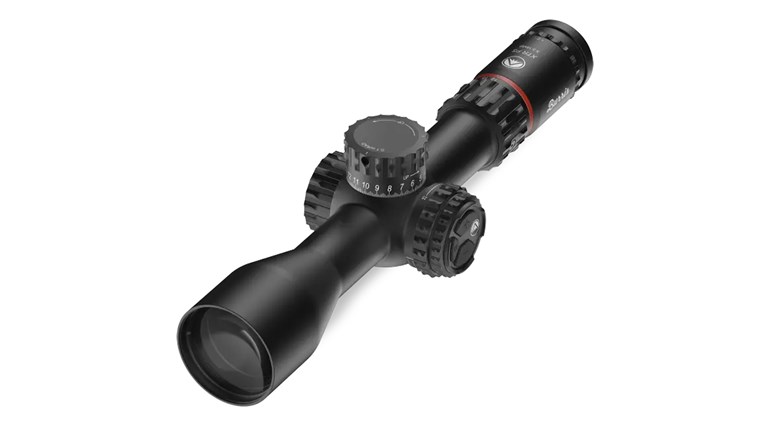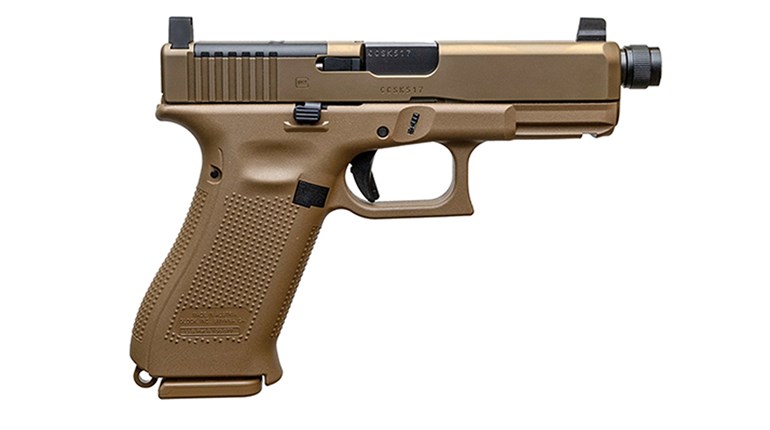
From the time that some unknown gunsmith filed a notch-and-post sight into what was probably a wheellock or flintlock pistol until just a few years ago, fighting handgun sights evolved very little. Sure, a set of Bo-Mar, Heinie or Novak sights are vastly superior to the primitive irons of the blackpowder age, but, at the end of the day, we’re still talking about a notch-and-post arrangement with all of its shortcomings. Technology took a leap forward in the early 1980s when competitive pistol shooters began mounting red-dot sights to their handguns, but those beer-can-size optics were far too bulky for practical use. Everything changed, however, when technology advanced sufficiently to bring us miniaturized reflex optics small enough to be mounted to the slides of any duty-size handgun. Then the advantages of a dot optic were suddenly available even in a concealable package. Last year, Glock released its line of MOS (Modular Optic System) pistols, which came factory-equipped to accept optics without having to alter the slide. Initially, all of the MOS pistols were long-slide competition- or hunting-style handguns. For 2016, Glock has expanded its MOS line to include two of the most popular 9 mm handguns on the planet: the Glock G17 and G19.

Why an optic? One of the challenges of mastering the handgun is sight alignment, the eyeball dance between the target, the front sight and the rear sight. Shooting a handgun with an optic essentially eliminates this challenge; by “optic,” I’m referring to the dot-style reflex optics typified by the popular Trijicon RMR. These products reflect an image, often a red circle or dot, onto a windshield-like glass or polymer window. Instead of three separate objects on which to focus (target, front sight, and rear sight), there’s only the dot and the target, both of which are on the same visual plane. With a properly zeroed optic, the shooter simply places the dot on the target and presses the trigger. It doesn’t matter whether the dot is centered in the window, if the dot is on the target, the aim is true.

Let’s talk about the guns themselves. The 30-year-old Glock G17 needs little, if any, introduction. Both it, and the more compact G19 have been mainstays of worldwide law enforcement, military and personal defense for decades. All MOS Glocks are Gen 4 models and have a flat milled into the top of the slide, just forward of the rear sight dovetail. This void is covered by an almost seamless steel cover plate, secured by two small Torx screws—with the cover in place, the Glock looks, handles, and fits into a holster normally. Removing the cover reveals two blind, tapped holes that allow for the mounting of a series of plates. MOS Glocks come with a set of four adapter plates designed to accommodate the most popular reflex optics currently on the market. Adapter One is compatible with the EOTEch, Docter, Meopta, and Insight optics; adapter Two works with the Trijicon RMR; adapter Three is used with the C-More and Vortex; and adapter Four is for the Leupold Delta Point series of sights. Other sights may fit these adapters, so this list is not exhaustive. Adapting to future optics would be as simple as a new plate, hence the “modular” designation.

We mounted a 2.5-MOA dot Leupold Delta Point Pro to the G17 for our testing and an adjustable LED model Trijicon RMR with a 3.25-MOA dot to the Glock 19. As for dimensions, the Delta Point Pro extends 1.15 inches above the Glock’s slide and sits .30-inch wider at its widest point. The RMR is slightly smaller, measuring .90 inch above the slide and adding .30 inch to the width. The RMR weighs 1.2 ounces and the Leupold weighs 1.95 ounces, so the increased mass of the sight is about as much as adding two to three rounds of 9 mm ammo; very much a non-issue. Both of these sights use batteries, but battery life is long—typically longer than a year. Tritium and fiber-optic versions of the RMR are available if you’re looking to eliminate electricity from the equation. It is not possible to use the traditional sights when an optic is mounted but, if the sight malfunctions, one can use the frame of the optic “window” as a crude but effective ghost-ring.
I know what you’re thinking: Why would you want to put something on a handgun that makes it larger and more difficult to conceal? Everyone’s body type and particular style of carry may be slightly different, but we did not find the addition of the optics to be a factor in the concealment of these handguns. Because it doesn’t add to the length of the grip or barrel, it does very little to increase “printing” of the gun through clothing. If you’re wearing a holster and garment that allows you to conceal either of these handguns in the first place, it is unlikely the addition of the optic will be a game-changer. In situations where the handgun is carried openly, the optic is most definitely a non-factor in size.
The handling characteristics of the handguns are not changed in a noticeable way, since these small reflex optics are so small and lightweight. One side benefit is that the vertical face of any of these optics affords the user is the ability to use the optic as an aid to rack the slide. Not only does the optic prevent the weak hand from sliding off the back of the slide under stress, racking the slide one-handed by catching the optic on a belt or barricade becomes an easy task—something that doesn’t have a lot of utility until one finds their hand injured, in which case it would become very useful.

Mounting the sights was simple using the hardware included with both the sights and the Glock-made adapters. One simply selects the correct adapter plate for the sight being used, and attaches the plate to the slide using two included Torx screws. The sight is then attached to the adapter plate using the standard hardware. The setup is simple and durable. Zeroing the optic is done via windage and elevation screws. We zeroed both handguns at 25 yards.
Bench testing a handgun for accuracy is not one of my favorite tasks—it’s a tedious and time-consuming process to ensure you’re getting the best out of a handgun with minimal human error. The addition of the optics made 25-yard testing with these handguns relatively painless. With the simplicity of keeping the red dot centered on target, consistent grip and trigger control became the only concerns. The optic allowed us to really show off the accuracy potential of the handguns and the G17 in particular proved to be extremely accurate. As you can see from the accuracy table, Hornady’s Critical Defense ammo kept all but one five-shot group under 1 inch and the groups using the DoubleTap lead-free load were only slightly larger. Accuracy often comes at the cost of reliability, but not in this case. Both guns functioned with 100-percent reliability using FMJ, JHP and FTX ammunition.
It is easy to brush-off the importance of accuracy in a defensive handgun but active-shooter events should force us to abandon the 7-yard mindset. Look down the aisles in a big-box store or across any parking lot and you’ll realize that the ability to hit a target at dozens of yards could save the lives of many innocent Americans. To gauge the MOS Glocks’ aptitude for such a task, we set up a standard steel popper target and fired at it from both the prone and seated positions at 80 yards. Hitting the target more than 75 percent of the time didn’t take a tremendous amount of concentration, just careful trigger control. I’m not claiming that making that type of shot under stress would be easy, but the equipment is up to the task.

Most things in life are a trade-off, but one of the interesting things about using a non-magnified optic on a handgun is not only does it aid in precision shooting, it also is tremendously helpful in shooting with speed. It takes some getting used to for shooters accustomed to looking for their front sight but, once you get the hang of it, it’s incredibly fast and easy. Some old-timers may disagree, but a handgun with a reflex optic is a fantastic way to teach new shooters how to shoot a handgun. They are more likely to find success faster with the simplicity of the red-dot and that positive feedback will help hold their interest. Once the fundamentals have been achieved, the instructor can always transition to an iron-sighted handgun and introduce the skill of sight alignment.
Statistics tell us bad things happen at night, in diminished light conditions. Reflex optics are a serious advantage in low light. During the course of this testing, I found myself hunting with another reflex-equipped Glock, the 10 mm Glock 40 MOS. A whitetail doe emerged at the absolute end of legal shooting hours and I was able to take her with a single 180-grain bonded soft-point. Even with tritium night sights, I would not have been able to ethically take that shot. An ideal handgun for home defense would be one of the optics-equipped MOS Glocks with the addition of a white light mounted on the accessory rail. I’ve yet to use a handgun with an optic in any force-on-force training scenario, but I’m willing to bet the dot would really demonstrate its utility as a defense tool under that type of stress.
Reflex optics on defensive handguns are here to stay, so much so that USPSA (the largest governing body of practical pistol shooting in the U.S.) has established a provisional Carry Optics division to accommodate the ever-growing list of production and custom optics-equipped carry guns. In the G17 and G19 MOS pistols, we have reliable and accurate duty- and concealment-size handguns that offer all of the inherent advantages of reflex optic-equipped handguns. Hitting with these handguns can be achieved faster and at greater ranges when equipped with a quality optic, and the trade-off in size is minimal. What was previously a custom-only proposition is now available in a factory handgun.




































